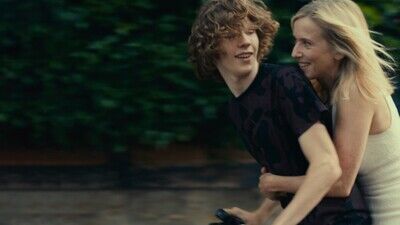“Last Summer” keeps the rationale behind Anne’s attraction toward Théo a teasing mystery. Is that something you and Léa Drucker discussed? Did you view Anne’s desire for him as anything more than carnal?
I don’t talk to my actors on set, and I don’t discuss psychology in general. I believe that the choreography and the blocking communicate the characters’ psychology—it’s not a conversation for me to have with them.
In terms of what happens for Léa’s character, it was very important that there be no kind of predatorial seduction [on Anne’s part, as is the case in the Danish film]—it needed to be something that happened to her in a moment that she’s caught off guard. She sets up a pact with him—when she says, “I won’t tell your father [that you robbed his house] if you agree to integrate [with] the family,” it’s at that moment that she signs her death warrant as a happily faithful wife. In that scene, he still looks very childish, quite chubby—he’s not beautiful in any sexualizable way—but at some point, he looks up at her, and suddenly the camera comes in very close, his face gets thinner, and his features get sharper, and he looks at her like a woman. That gaze is what she’s eventually going to succumb to because it’s a gaze that is hard to resist—it carries the promise and the potential to make oneself younger again.

Much has been made of the fact that, in the film’s incredible sex scenes, the camera focuses closely on Anne’s face. Was that strategy something you knew you wanted before shooting? Or does it develop on set?
Everything is figured out on set. It’s through [the actors’] flesh that you have to find the beauty and the ecstasy that’s possible between them—not before. If there’s any forethought, it’s the night before in a state of panic. [laughs] But I always try to say what I’m going to do [in] a scene before I do it with my actors.
[Drucker] was worried because she had never in her whole career done an intimate scene and she’s 50 years old—she was scared that she might seem ridiculous [opposite] such a young body. I told her I was interested in what happens to the bodies as they make love, but not in the form of the bodies—[I was interested] in what is perceivable on the face, so [I would use] these closeups of the face. It is the nudity of the face that I’m interested in and the vulnerability and the intimacy of that.
She was relieved that [I] was somehow letting her off the hook, but I told her, “Don’t think that, it’s a lot harder and it’s a lot more intimate.” She came to realize that, indeed, whenever it comes to a wider shot where her body’s involved, the physical blocking of that and the choreography of that is so technical that it just becomes something else—but when the camera was close to her and she was trying to offer her face in this completely unguarded way, the camera felt like it was devouring her. That’s when she needed to really delve into all of her tools as an actress to be able to offer the performance that she did.

